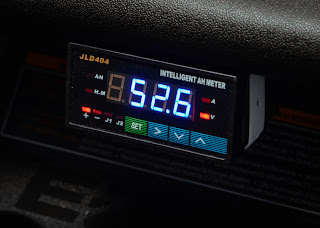The best way is to count amp-hours (or watt-hours). The emerging standard in the EV community is the JLD-404 meter. Here is the meter connected to lead wires, but not mounted. The EX-RAY speedometer is also shown mounted on the steering column, but not hooked up.
The meter requires 12 to 30 Volts DC, preferably un-switched so that the meter retains the settings. All low power out of the EZGO DC-DC converter were wired for switched power, so I had to install a new pin in the unused un-switched position. This wire and a ground wire fed the meter.
A separate pair of lead wires were connected to the 200 amp shunt for measuring mV readings from 0 to 75 mV which are converted into amps based on the resistance of the shunt.
One addition wire was connected to the positive lead of the pack to allow measurement of the pack voltage.
All of the wires between the dash and the battery compartment had to go in the wiring channel beneath the floor mat. Note that all of these screws/bolts use the TORX style driver tool which required another trip to the hardware store.
Finally the meter was secured to the underside of the dash with a plastic strap and 2 screws. The battery switch was turned on. It came on for an instant then died. Even though the meter only draws 0.04 amps I suspected the 0.2 amp AGC glass fuse in the power lead wire. Sure enough the surge during power up blew the fuse and did the same with a second one. Another trip to the auto parts store for a 2 amp fuse. Power on and it came to life! The settings were input using the information from the on-line manual posted by EVTV; thank you Jack.
Here is the meter displaying amp-hours
By clicking the ">" button you cycle through AH, Time, Amps and Volts. Here it is displaying amps. I have found that it takes about 0.2 amps to keep the contactor closed when the cart ignition key is on.
Here the meter is displaying the pack voltage
A quick test drive confirmed that it seemed to be working as it was supposed to.
Next post, installation of the EX-RAY speedometer/odometer.




No comments:
Post a Comment
Please leave your feedback and share your thoughts and experiences, but please be factual and keep the tone friendly. Personal attacks and political references will be deleted.